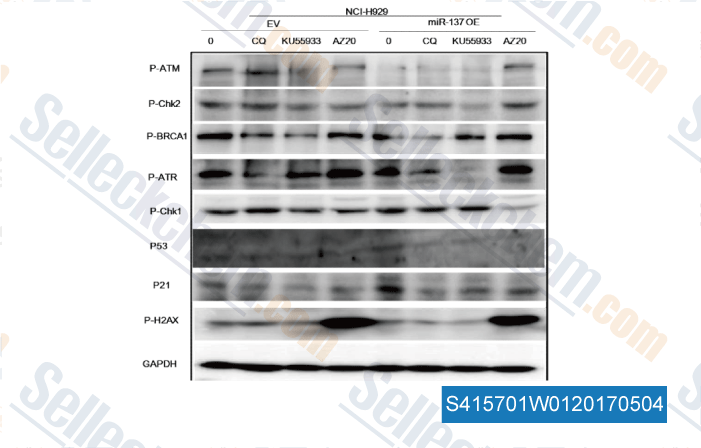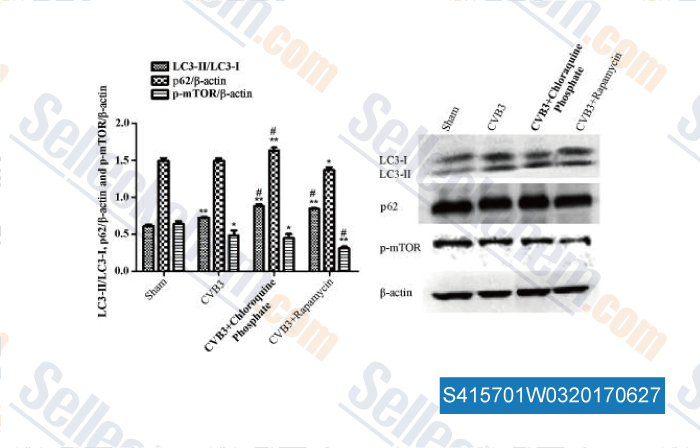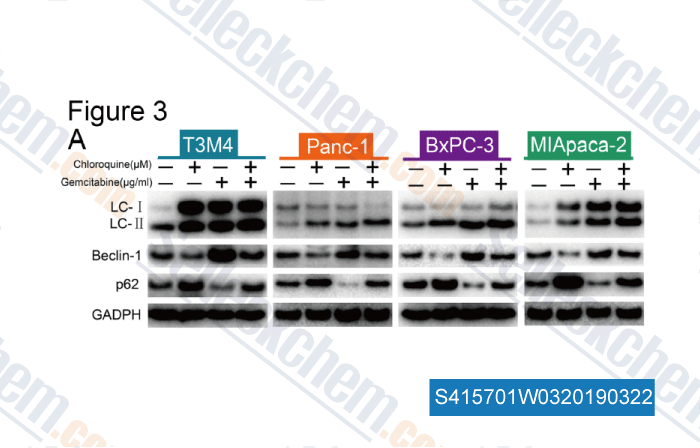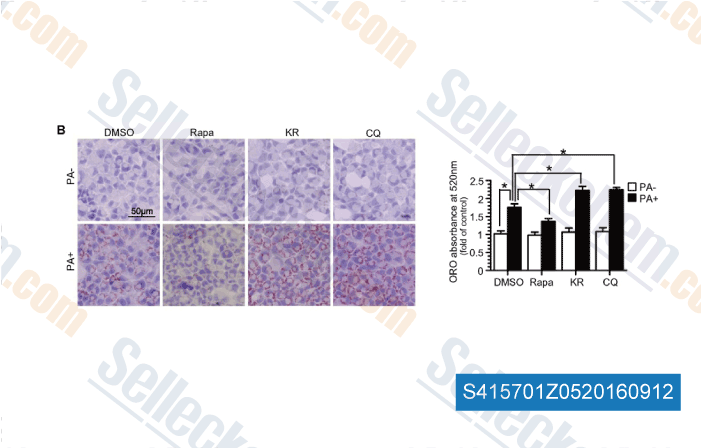|
Toll Free: (877) 796-6397 -- USA and Canada only -- |
Fax: +1-832-582-8590 Orders: +1-832-582-8158 |
Tech Support: +1-832-582-8158 Ext:3 Please provide your Order Number in the email. |
Technical Data
| Formula | C18H26ClN3.2H3O4P |
|||
| Molecular Weight | 515.86 | CAS No. | 50-63-5 | |
| Solubility (25°C)* | In vitro | Water | 100 mg/mL (193.85 mM) | |
| DMSO | Insoluble | |||
| Ethanol | Insoluble | |||
|
* <1 mg/ml means slightly soluble or insoluble. * Please note that Selleck tests the solubility of all compounds in-house, and the actual solubility may differ slightly from published values. This is normal and is due to slight batch-to-batch variations. * Room temperature shipping (Stability testing shows this product can be shipped without any cooling measures.) |
||||
Preparing Stock Solutions
Biological Activity
| Description | Chloroquine diphosphate is a 4-aminoquinoline anti-malarial and anti-rheumatoid agent, also acting as an ATM activator. Chloroquine is also an inhibitor of toll-like receptors (TLRs). | |||||
|---|---|---|---|---|---|---|
| Targets |
|
|||||
| In vitro | Chloroquine is a chemotherapeutic agent for the clinical treatment of malaria. Chloroquine is able to bind to DNA, and inhibit DNA replication and RNA synthesis which in turn results in cell death. The effect of Chloroquine may also be related to the formation of a toxic heme-Chloroquine complex. Chloroquine inhibits trophozoite hemoglobin degradation through increasing vacuolar pH and inhibiting the activity of vacuolar phospholipase, vacuolar proteases, and heme polymerase[1]. Chloroquine possesses definite antirheumatic properties. Chloroquine has immuno-modulatory effects, suppressing the production/release of tumour necrosis factor and interleukin 6. Moreover, Chloroquine exerts direct antiviral effects, inhibiting pH-dependent steps of the replication of several viruses including members of the flaviviruses, retroviruses, and coronaviruses. Its best-studied effects are those against HIV replication[2]. Chloroquine can accumulate inside the macrophage phagolysosome by ion trapping where it exerts potent antifungal activity against Histoplasma capsulatum and Cryptococcus neoformans by distinct mechanisms. Chloroquine inhibits growth of H. capsulatum by pH-dependent iron deprivation, whereas it is directly toxic to C. neoformans[3]. |
|||||
| In vivo | Chloroquine has tumor‑inhibitory and tumor‑promoting effects in triple‑negative breast cancer. |
Protocol (from reference)
| Cell Assay: |
|
|---|---|
| Animal Study: |
|
References
Customer Product Validation

-
, , Leukemia, 2017, 31(5):1123-1135

-
, , Int J Mol Med, 2017, 40(1):182-192

-
Data from [Data independently produced by , , Cancer Lett, 2018, 436:129-138]

-
Data from [Data independently produced by , , Cell Signal, 2016, 28(8):1086-98. ]
Selleck's Chloroquine diphosphate has been cited by 216 publications
| Noncanonical function of folate through folate receptor 1 during neural tube formation [ Nat Commun, 2024, 15(1):1642] | PubMed: 38388461 |
| Macroautophagy/autophagy promotes resistance to KRASG12D-targeted therapy through glutathione synthesis [ Cancer Lett, 2024, 604:217258] | PubMed: 39276914 |
| Shaoyao-Gancao Decoction, a famous Chinese medicine formula, protects against APAP-induced liver injury by promoting autophagy/mitophagy [ Phytomedicine, 2024, 135:156053] | PubMed: 39326138 |
| KIFC1 depends on TRIM37-mediated ubiquitination of PLK4 to promote centrosome amplification in endometrial cancer [ Cell Death Discov, 2024, 10(1):419] | PubMed: 39349439 |
| Inducing Receptor Degradation as a Novel Approach to Target CC Chemokine Receptor 2 (CCR2) [ Int J Mol Sci, 2024, 25(16)8984] | PubMed: 39201670 |
| Targeting autophagy as a therapeutic strategy in pediatric acute lymphoblastic leukemia [ Sci Rep, 2024, 14(1):4000] | PubMed: 38369625 |
| A high-throughput response to the SARS-CoV-2 pandemic [ SLAS Discov, 2024, 29(5):100160] | PubMed: 38761981 |
| Lysosomes mediate the mitochondrial UPR via mTORC1-dependent ATF4 phosphorylation [ Cell Discov, 2023, 9(1):92] | PubMed: 37679337 |
| Lysosomes mediate the mitochondrial UPR via mTORC1-dependent ATF4 phosphorylation [ Cell Discov, 2023, 9(1):92] | PubMed: 37679337 |
| Genome homeostasis defects drive enlarged cells into senescence [ Mol Cell, 2023, 10.1016/j.molcel.2023.10.018] | PubMed: 37977116 |
RETURN POLICY
Selleck Chemical’s Unconditional Return Policy ensures a smooth online shopping experience for our customers. If you are in any way unsatisfied with your purchase, you may return any item(s) within 7 days of receiving it. In the event of product quality issues, either protocol related or product related problems, you may return any item(s) within 365 days from the original purchase date. Please follow the instructions below when returning products.
SHIPPING AND STORAGE
Selleck products are transported at room temperature. If you receive the product at room temperature, please rest assured, the Selleck Quality Inspection Department has conducted experiments to verify that the normal temperature placement of one month will not affect the biological activity of powder products. After collecting, please store the product according to the requirements described in the datasheet. Most Selleck products are stable under the recommended conditions.
NOT FOR HUMAN, VETERINARY DIAGNOSTIC OR THERAPEUTIC USE.
